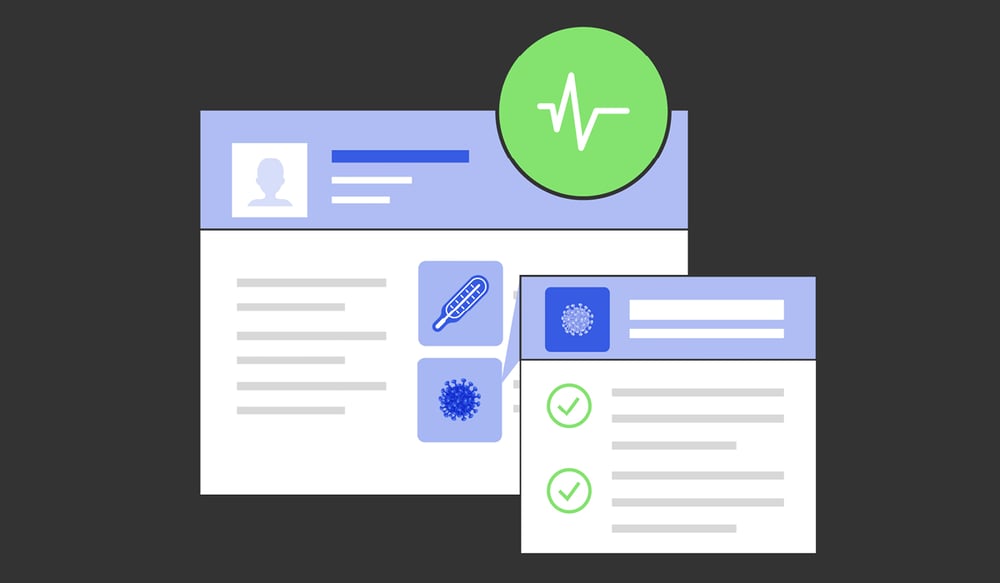Infection control is an essential aspect of managing a hospital or healthcare organization. While traditional infection preventionists relied on manual data entry and other inefficiencies that hindered their ability to manage information, modern hospital infection control software enhances a healthcare organization’s ability to reduce the spread of infections by using advanced workflows.
Below, we assess the core components of infection control software and discuss how incorporating this technology into healthcare safety protocols benefits your facility in its goal to improve safety for all.
Infection control and infection prevention
In the broad sense, infection control and prevention refers to the practice of actively mitigating the risk of healthcare-associated infections. On the patient safety and risk management side, infections are considered to be healthcare “incidents” or “events.”
Clinicians and staff use a variety of strategies to manage infection control and prevention. That includes following essential handwashing and sterilization procedures and consistently adhering to other sanitation recommendations. In addition, healthcare providers and staff must accurately document any hospital-acquired patient infections for tracking and control purposes. Consistency and timeliness are vital to managing infections, which is easier with the right software.
What is infection control software in hospitals?
Infection control software is a suite of tools designed to facilitate the reporting and analysis of infections. Specifically, it’s used to track hospital-acquired infections. By keeping detailed records of these incidents, your staff will be better equipped to control outbreaks and improve the overall quality and safety of care you provide.
Infection control tools are included in a comprehensive incident and risk management application, or can be used in conjunction with patient safety software that contains features and functions such as the following:
Customizable workflows
Infection control software incorporates customizable workflow tools that allow you to track and manage patients and staff who have acquired a given infection. Such workflows enhance your infection prevention protocols and ensure that no steps in the process are missed.
For example, you can ensure that rooms were cleaned before reuse, tools were sterilized, and employees are following sanitation protocols. To aid with prevention protocols, the software contains checklists, assessment tools, and auditing features.
Real-time location system (RTLS)
Infection control software may also include a real-time location system (RTLS) to aid staff in immediately locating patients within your facility for further disease prevention. This tool becomes invaluable for tracking an individual’s location history and taking the necessary steps to sanitize those workstations and prevent further infections.
Predictive surveillance
Infection control software also provides a predictive surveillance component. Predictive surveillance is the practice of collecting large amounts of data and analyzing this information. Through this type of analysis, you can identify potential outbreak trends and proactively prevent them. And typically, customizable dashboards give decision-makers the views they need for allocating resources to mitigate the effects of an outbreak.
Data collection and analysis capabilities
When it comes to gathering and analyzing infection control data, at worst delays can cause widespread injuries or deaths. At a minimum, delays or errors bring regulatory penalties and reputational damage. Manually relaying infection information is time-consuming and tedious. Infection-related communication is frequently delayed, sensitive data is exposed to more individuals than is necessary, and other challenges arise that can affect the organization’s ability to control the outbreak.
Infection control software allows your team to share data in real-time, it automatically analyzes the data, and provides feedback that your team needs to control infections more effectively, all while keeping data secure. Incident reports in particular can play a significant role in protecting patients and staff. For example, in cases where staff, patients, or others see that protocols aren’t followed, they can register complaints and suggestions to help prevent infections.
Case management
Infection control software also includes case management capabilities. This is an essential tool for all patients, especially those admitted to your facility for an extended period. Your staff will be able to closely monitor their progress, make needed changes to the care plan, and protect the patient and staff from infection risks—even after they have been discharged.
What are the benefits of infection control software?
Infection control software offers a broad range of benefits to your hospital or healthcare organization. Some of the most notable advantages include the following:
It saves lives
Elderly patients and those who are immunocompromised are at exceptionally high risk of infection or death during an outbreak. Implementing infection control software not only improves the care experience but can also save untold numbers of lives. Healthcare provider organizations must act in the best interest of patients, staff, and frequently, the entire community. Infection control software helps you accomplish that mission.
It facilitates easier reporting to the government
Laws often require a facility to report infection outbreaks. By using a centralized database, you can quickly take command of the mandatory internal and external communication necessary to comply. Online reporting and the ability to fully align your infection control software with your organizational structure and procedures enable you to meet requirements at any given time, without the need for IT support.
It produces data in real-time, for actionable insights
Once your infection control software is live, you have access to valuable data that will provide insights into your current protocols. You can identify positive trends and improve your processes for infection control and prevention. The effect is a safer patient care experience—as well as increased safety for front-line clinicians. Time is essential when there is an infection outbreak, requiring a software solution that delivers insights in real-time to pinpoint weaknesses or missed opportunities for safety. Your staff will be able to immediately access real-time patient and infection-related data. That capability ensures that all pertinent patient and staff infection information gets communicated between various staff members, departments, and sites system-wide in a timely manner.
It enables cross-departmental coordination
Like virtually every other hospital, your facility includes a multitude of departments that run clinical and administrative healthcare operations. In addition to your own personnel, you may also host providers and surgeons from other healthcare organizations, medical students, vendors, and others. Infection control software allows various departments and professionals to coordinate care or visits and share information seamlessly. Ultimately, infection control software reduces the risk of an infection going unaddressed when a patient is transferred from one department to another, or a clinician or staff member treats a potentially exposed patient during their daily activities across a facility.
It’s cost-effective
Like most facilities, you are probably searching for ways to reduce costs without diminishing the patient care experience, safety, or quality. Infection control software is an excellent way to meet that goal. It streamlines communication between staff, which increases their ability to work efficiently. In addition, you are reducing the risk of infection outbreaks, which will insulate your facility from civil liability and the associated litigation costs.
Implementing hospital infection management
If you want to implement hospital infection management technologies, consider upgrading to comprehensive patient safety software. This technology includes workflows, data management tools, and a user-friendly interface that can improve the effectiveness of your entire care team.
Infection control software is also included with comprehensive patient safety platforms. This all-in-one solution can drastically enhance the patient care experience.
Infection control software FAQs
If you seek additional information about infection control software, here are some frequently asked questions, along with answers based on The Patient Safety Company’s experience working with hospitals and healthcare organizations worldwide for more than 15 years.
What is an infection control program?
An infection control program is a formal set of regulations and protocols that are implemented in a healthcare facility or across a healthcare system. It typically includes digital software for tracking and reporting infections and more. An infection control program addresses potential risks for viral and bacterial outbreaks within a hospital or other care facility.
What are five infection control practices?
The five infection control practices are hand hygiene (handwashing), use of personal protective equipment (PPE), safe handling/disposal of sharps, safe handling/disposal of chemical waste, and safe management of blood/bodily fluids. All can be monitored within an infection control software program.
What’s the basic technique for infection control?
The most basic technique for infection control is proper and frequent handwashing. This simple practice has been shown to reduce the risks of infections, especially within the healthcare setting.
What’s the most effective method of infection control?
Aside from prevention, the most effective method of infection control is thorough decontamination. That includes hand washing, disinfecting work surfaces, and sterilizing all equipment.
Can infection control software improve patient outcomes?
Yes; an infection control software system can provide clinicians with real-time data that they can use to mitigate outbreaks within healthcare facilities. Infection preventionists can be more proactive with outbreak countermeasures, as well.
Can infection control software curb the spread of illnesses?
Yes; when used properly, infection control software can help clinicians curb the spread of various illnesses. It provides enhanced tracking capabilities and actionable data that can guide patient care and prevention protocols.
Explore The Patient Safety Company’s versatile solutions for infection control, patient safety, risk management, patient satisfaction, and more. Contact us today for a free online demo.


%20(3)%20(1).jpg)


